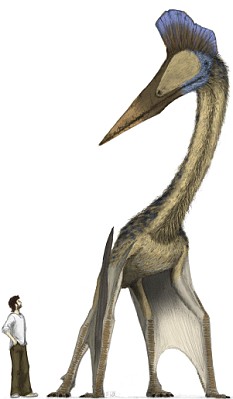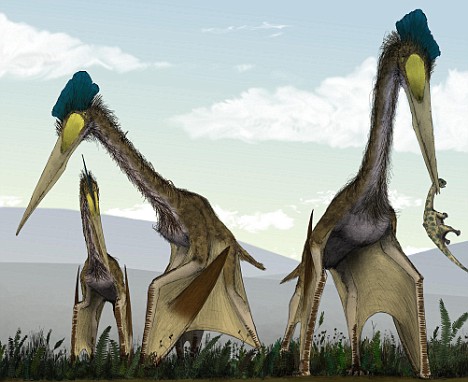Azhdarchids: Sky Dragons
Posted by: Loren Coleman on May 28th, 2008

New fossil flying reptile news – they walked more than they flew. How scientists know boggles the mind, but there it is. Congratulations to Darren Naish, yet again.
Azhdarchids, named after the Uzbek word for ‘dragon’, were gigantic toothless pterosaurs. Azhdarchids include the largest of all pterosaurs: some had wingspans exceeding 10 metres and the biggest ones were as tall as a giraffe!

Azhdarchids were probably better than any other pterosaurs at walking because they had long limbs and skulls well suited for picking up small animals and other food from the ground.
About Loren Coleman
Loren Coleman is one of the world’s leading cryptozoologists, some say “the” leading living cryptozoologist. Certainly, he is acknowledged as the current living American researcher and writer who has most popularized cryptozoology in the late 20th and early 21st centuries.
Starting his fieldwork and investigations in 1960, after traveling and trekking extensively in pursuit of cryptozoological mysteries, Coleman began writing to share his experiences in 1969. An honorary member of Ivan T. Sanderson’s Society for the Investigation of the Unexplained in the 1970s, Coleman has been bestowed with similar honorary memberships of the North Idaho College Cryptozoology Club in 1983, and in subsequent years, that of the British Columbia Scientific Cryptozoology Club, CryptoSafari International, and other international organizations. He was also a Life Member and Benefactor of the International Society of Cryptozoology (now-defunct).
Loren Coleman’s daily blog, as a member of the Cryptomundo Team, served as an ongoing avenue of communication for the ever-growing body of cryptozoo news from 2005 through 2013. He returned as an infrequent contributor beginning Halloween week of 2015.
Coleman is the founder in 2003, and current director of the International Cryptozoology Museum in Portland, Maine.










What a marvelously strange and dangerous place was early Earth!
How shocking those pictures are they are truly gigantic I wonder if these things may still be alive.
Interesting, I wonder how these animals were capable to taking to the air. Were they dependant of air currents coming from the sea and high cliffs, like their “New World” counterpart Quetzalcoatlus?
We also have to keep in mind that according to the modern teory of aerodynamics, the bumblebee shouldn’t be capable of flying 😉
It’s a stunning bit of new thinking, and kudos to Darren. The only thing that gives me pause is whether the largest of these creatures were capable of a quick takeoff while stalking on flat ground – a necessity for survival in an environment with big, fast, bipedal predators. They look awfully vulnerable if actually caught on the ground, especially given the largely unsupported membranes of pterosaur wings – one good tear, and they’re ground-bound.
I’m also puzzled that evolution did not select for bigger, stronger feet.
(Just for fun addition – the “science says bees can’t fly” thing is a very old claim, long since disproven.)
Wow! Truly amazing looking creatures! That has to be the most fascinating pterosaur I’ve ever seen!
The drawings depict better foot like structures on their limbs than any other pterosaurs that I’ve looked at. They mainly just had claws at the end of their limbs. One of the articles says that they were small padded feet, like a mammals paws maybe? How fast could they move on the ground? Could they run and take off or did they need a cliff or hill to take to the air? Hmm I think I must now go to Google and find out! LOL
Great find guys!
Awesome, terrifying creatures…
Would not want to even see one in real life.
“There were giants in the earth in those days…”
Wow, those guys were huge! Thank you for the great article Loren!
Just goes to show you that there are strange things in the world, even if most of them did die out. Mother Nature loves infinite variety and after looking at Azhdarchid, who knows what other strange things may have existed, and more importantly, may exist now.
🙂